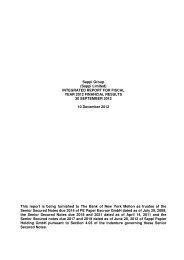2007 Annual Report - Sappi
2007 Annual Report - Sappi
2007 Annual Report - Sappi
You also want an ePaper? Increase the reach of your titles
YUMPU automatically turns print PDFs into web optimized ePapers that Google loves.
Notes to the group annual financial statements continued<br />
for the year ended September <strong>2007</strong><br />
2. Accounting policies continued<br />
disclosure reconciling the headline earnings to the earnings<br />
applied in the earnings per share calculation.<br />
Specific departures from the old formula are as follows:<br />
• Not all gains or losses on the closure, sale or termination of<br />
a business will automatically be excluded from headline<br />
earnings.<br />
• A new approach is required for the recognition of a deferred<br />
tax asset of the acquiree, following a business combination.<br />
• Additional adjustments for any linked unit (where a share and<br />
debenture trade as a linked unit).<br />
• reclassification adjustments relating to components of other<br />
comprehensive income.<br />
This revised standard is effective for our September 2010<br />
year end.<br />
IFRS 7 – Financial instruments: disclosures<br />
The IFRS essentially combines IAS 30 – Disclosure in the<br />
Financial Statements of Banks and similar Financial Institutions<br />
and IAS 32 – Financial Instruments: Presentation. The disclosure<br />
requirements under IAS 32 have been expanded to include<br />
sensitivity analyses as well as disclosure of classes of financial<br />
assets and liabilities.<br />
This circular has not had a material impact on our reported<br />
headline earnings per share.<br />
2.6 Potential impact of future changes in<br />
accounting policies<br />
The following standards and interpretations, which have been<br />
issued but which are not yet effective and which are applicable<br />
to <strong>Sappi</strong>, have not been applied in these financial statements:<br />
IAS 1 – Amendment to International Accounting<br />
Standard 1 – Presentation of financial statements:<br />
capital disclosures<br />
The amendment requires the group to disclose information that<br />
will enable users of its financial statements to evaluate the<br />
entity’s objectives, policies and processes of managing capital.<br />
The amendment first becomes applicable to the group for the<br />
financial year ending September 2008.<br />
Revised IAS 1 – Presentation of financial statements<br />
The main changes from the previous standard require that an<br />
entity must present:<br />
• all non-owner changes in equity (that is, ‘comprehensive<br />
income’) either in one statement of comprehensive income or<br />
in two statements (a separate income statement and a<br />
statement of comprehensive income);<br />
• a statement of financial position (balance sheet) as at the<br />
beginning of the earliest comparative period in a complete<br />
set of financial statements when the entity applies an<br />
accounting policy retrospectively or makes a retrospective<br />
restatement;<br />
• income tax relating to each component of other comprehensive<br />
income; and<br />
The standard first becomes applicable to the group for the<br />
financial year ending September 2008, and we are currently<br />
assessing the impact of this on the group.<br />
IFRS 8 – Operating segments<br />
This IFRS introduces the concept of an operating segment; it<br />
expands the identification criteria for segments of an entity and<br />
the measurement of segment result. This statement will allow an<br />
entity to align its operating segment reporting with the internal<br />
identification and reporting structure.<br />
The standard first becomes applicable to the group for the<br />
financial year ending September 2010, and we are currently<br />
assessing the impact of this on the group.<br />
IFRIC 10 – Interim financial reporting<br />
The interpretation addresses an apparent conflict between the<br />
requirements of IAS 34 – Interim financial reporting and those<br />
in other standards on the recognition and reversal in financial<br />
statements of impairment losses on goodwill and certain<br />
financial assets. The interpretation concludes that an entity shall<br />
not reverse an impairment loss recognised in a previous interim<br />
period in respect of goodwill, or an investment in either an<br />
equity instrument or a financial asset carried at cost.<br />
The interpretation first becomes applicable to the group for the<br />
financial year ending September 2008, and we are currently<br />
assessing the impact of this on the group.<br />
IFRIC 11 – Group and treasury share transactions<br />
This interpretation addresses two issues. The first is whether<br />
the transactions should be accounted for as equity settled or as<br />
cash-settled share-based payment arrangements, and the<br />
92<br />
sappi limited | 07 | annual report
















